Text
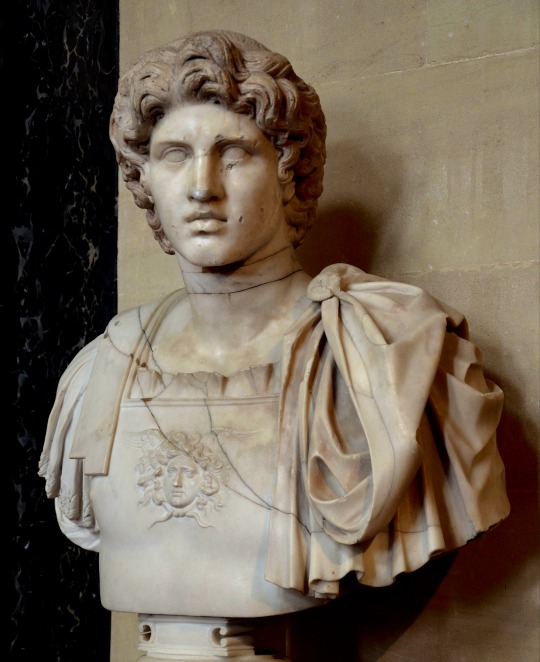
Roman bust of Alexander the Great, excavated from the ruins of Herculaneum.
-Blenheim Palace Oxfordshire, UK.
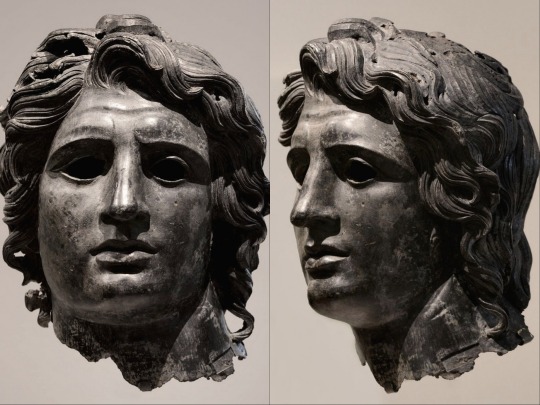
Bronze portrait of Alexander the Great. Greek or Roman, Late Hellenistic to Hadrianic ca. 150 B.c. - A.D. 138.
This posthumous portrait, with long "leonine" hair recalling Alexander's divine association with the hero Herakles, was probably from a cult statue.
-Metropolitan Museum of Art, NYC.
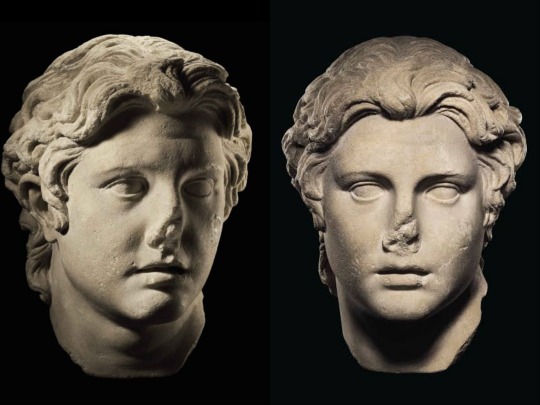
A Roman marble portrait of Alexander the Great. Circa 1st century AD.
The Macedonian ruler depicted lifesized, with a muscular neck, the laryngeal prominence bulging, his head turned to his right, his forehead creased, the deep-set eyes with modeled lids, his small mouth with parted lips, his thick, leonine hair swept up at the forehead in characteristic anastole.
-Antiquities, Sotheby's, London.

Marble head of a statue of Alexander the Great from the Court of the Passage of the Theoroi, Thasos, Greece. 2nd century AD.
Thasos was one of the first cities to worship Alexander as a god. An annual Alexandreia festival was held there on his birthday. This head features one of the most obvious examples of the "anastole" hairstyle characteristic of several portraits of Alexander.
-Thasos Archaeological Museum.
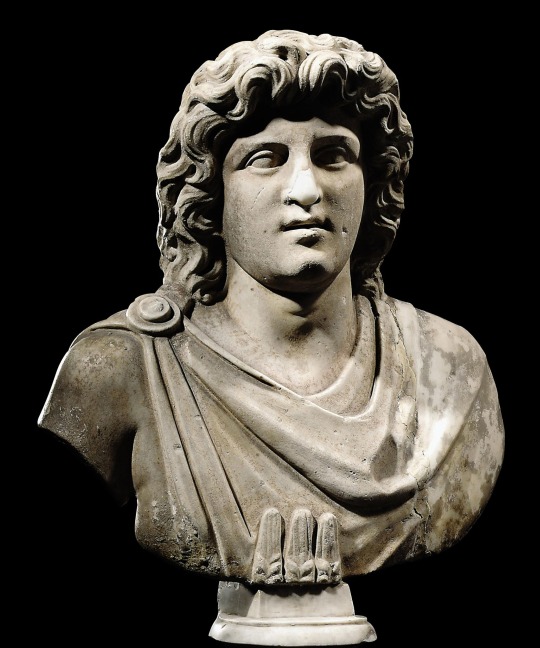
A Roman marble bust of Alexander Helios. Circa 1st Century AD.
His face framed by thick wavy hair, with seven recesses over the top of the head for insertion of bronze rays, wearing a chlamys fastened with a circular brooch at the shoulders, with three ears of wheat at the base of the bust, mounted.
-Formerly in a Swiss private collection, 1950s.
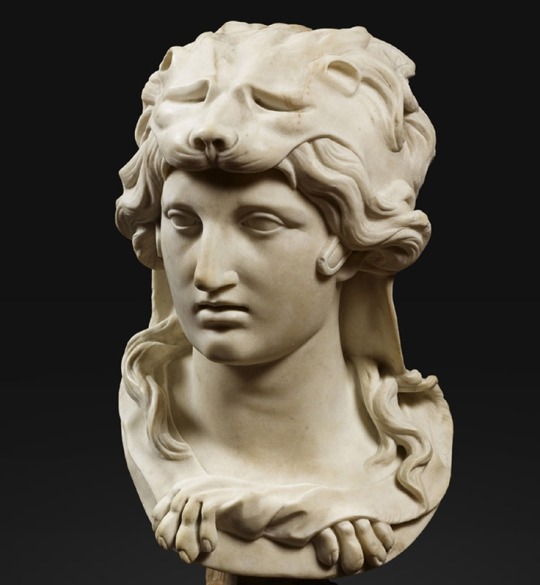
Bust of Alexander the great – Pierre II Legros known as Le Jeune.
This marble bust depicts Alexander the Great wearing a helmet reminiscent of his status of chief of the Macedonian armies. Wrapped in a lion’s skin, an attribute of Heracles, he also measures up to the twelve labors of this half mortal and half-deity hero, in light of his multiple military triumphs.

A monumental Roman marble head portrait of Alexander the Great.
Late Antonine period to early Severan period, circa late 2nd - early 3rd century AD.
-Marbury Hall, Cheshire, UK.
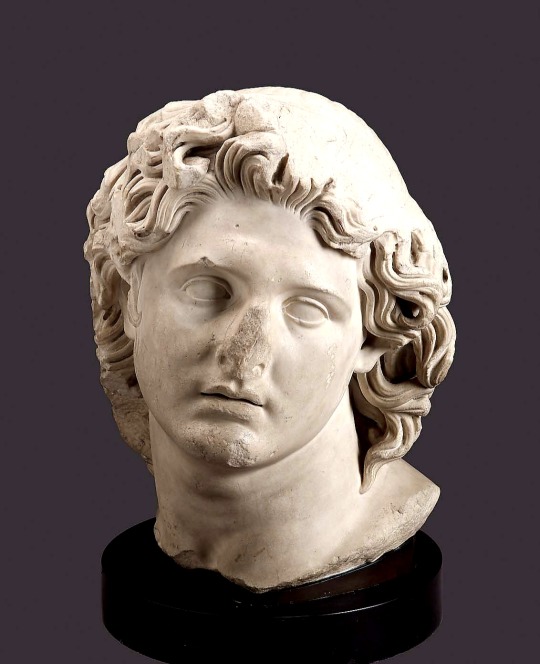
Head of Alexander the Great as Helios, Roman 2nd century AD.
Turned violently upward and to its own left, this head of Alexander the Great as Helios was carved to be let into a statue of nearly colossal proportions. The divine ruler was probably represented in the heroic nude with a cloak or aegis about the shoulders, concealing the join of the neck and shoulders. A ruler's rolled fillet encircles the head behind the leonine locks which enframe the face.
-Museum Of Fine Arts Boston.
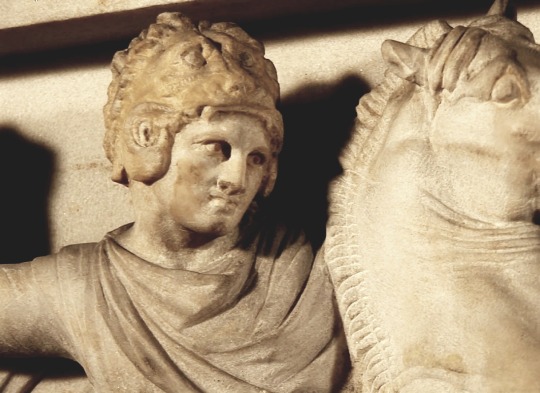
A detail of the relief on one of the long side of the Alexander sarcophagus. We see Alexander at the Battle of Issus (333 BC).
The King is shown wearing a lion-shaped helmet, which is perhaps a reference to Heracles, the hero who defeated the Nemean Lion, or otherwise serves to underscore his ferocity in battle.
-Istanbul Archaeological Museum.

Alexander the Great wearing a lion skin, a frequent attribute on monetary portraits alluding to Herakles, his mythical ancestor; inscribed letters on the face are later additions.
Pentelic marble, ca. 300 BC. Found in Kerameikon, Athens.
-National Archaeological Museum of Athens.
25 notes
·
View notes
Text
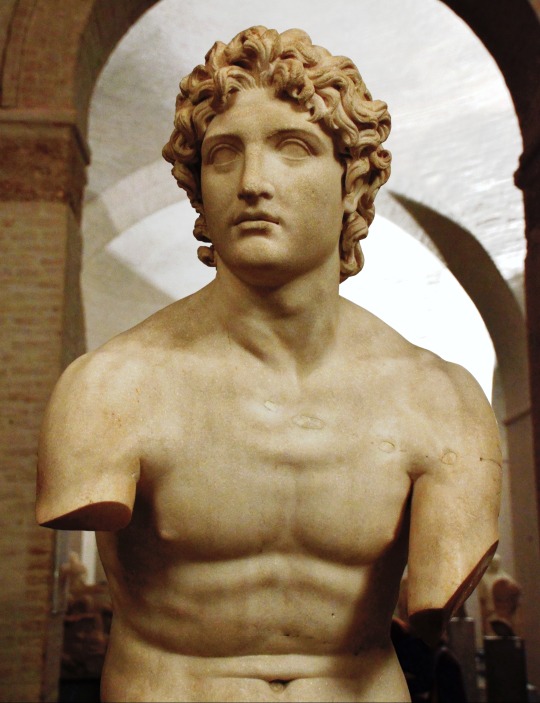
So called "Alexander Rondanini". Ancient copy, the original belongs to a group created by Euphranor: King Philip of Macedon on his chariot lead by 4 horses; his son Alexander, taking on the chariot, holds the reins in both hands.
Creation of the group after the Battle of Chaeronea, 338 BC.
-Glyptothek Munich.
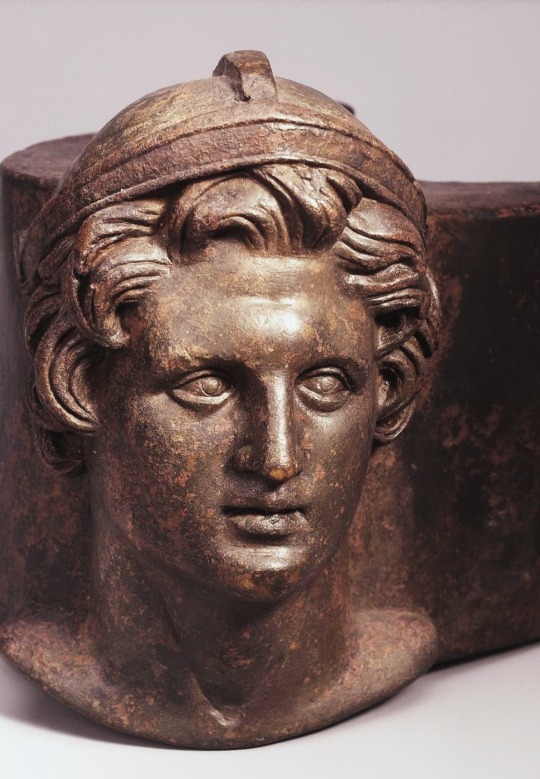
Part of a chariot is decorated with the relief head of a youth wearing a helmet. This head of a warrior repeats a pattern typical for the work of Lysippos, the court sculptor of Alexander the Great whose favourite material was bronze.
Created: Ancient Greece. 3rd century BC.
-State Hermitage Museum, St Petersburg.

Alexander the Great as Helios. Marble, Roman copy after an Hellenistic original from 3rd–2nd century BCE.
The lower part of the front of the nose and the bust have been restored. The identification of the head as Alexander-Helios is based on seven holes drilled around the top, thought to have supported metal solar rays.
-Palazzo Nuovo, Capitoline Museums, Rome.

Lysippos's statue "Alexander with a Lance," made in the 320s BC, portrayed Alexander armed and naked, echoing the great heroes of Greek mythology like Achilles with whom he identified.
He stood with his weight on one leg, one arm extended and holding a spear, the other hanging down at his side. This broken statuette, carved in the 100s BC, is a small-scale variant of that original.
-The J. Paul Getty Museum at the Getty Center (Los Angeles).
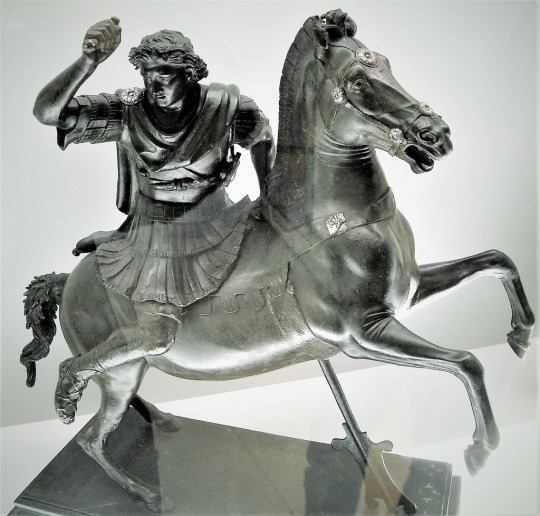
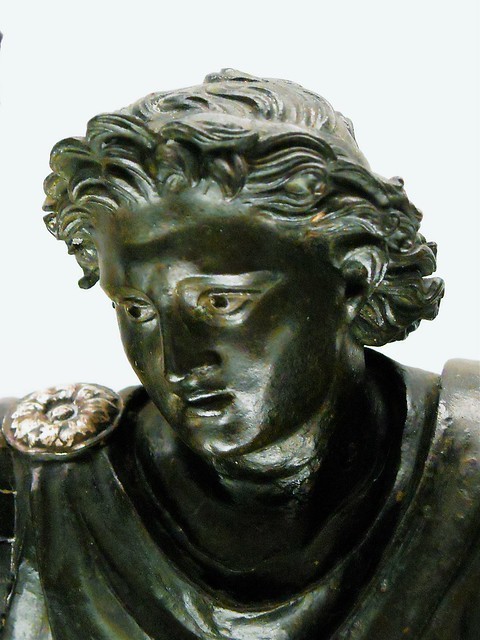
"Alexander the Great on Bucephalus" Bronze of the Roman period (1st century BC) from the original by Lysippos (4th century BC).
Alexander, with swept-back, wavy hair, wears a royal diadem, a short chlamys (cloak), a cuirass over a short chiton, and laced high military sandals. The figure originally held a sword in his right hand, and reins in the left, probably both of silver.
-Naples, Archaeological Museum.

This bronze statue is dated to the 2nd century BC (late Hellenistic period).
It's actually a portrait of Alexander the Great. This attractive hypothesis was confirmed by comparative studies with other ancient portraits of Alexander, made by the sculptor Lysippos. The whole work evokes the style of the sculptor: the attitude, the proportions, but especially the hairstyle and a certain melancholy of the features.
-Ephèbe Museum and Underwater Archeology, Agde, France.

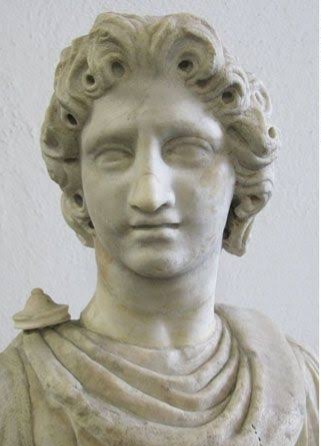
Marble statuette of Alexander the Great. Around 150 AD.
The statuette may have been at first restored as Archangel Michael. It was restored again as a Roman emperor, probably after the French Cardinal Melchior de Polignac took it with him on his return to Paris.
-Pergamon Museum, Berlin.
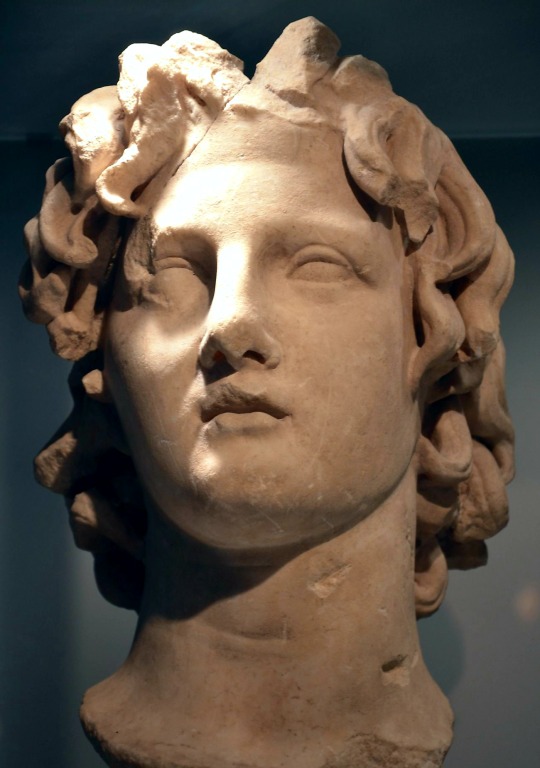
Marble head of Alexander the Great in his early years.
-Ny Carlsberg Glyptotek, Copenhagen.
11 notes
·
View notes
Text

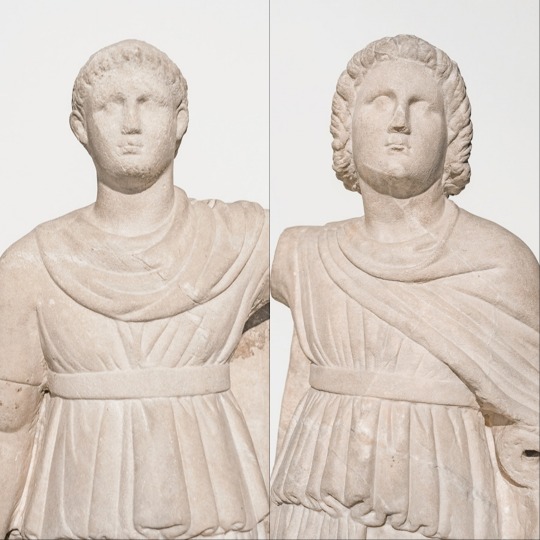
Marble statuettes of Hephaistion (left) and Alexander the Great from Egypt. Probably 1st century BC. From a statue group erected in Alexandria in Hephaistion's honour.
The figures stand in mirrored contrapposto poses, each with the opposite arm raised. Each wears a chlamys, chiton, zona belt and open-toed, lace-up boots. It is tempting to speculate that the figures were placed next to each other, each holding a horse, in the manner in which the twin divine horsemen heroes Castor and Pollux (the Dioskouri) were represented in sculptures and coins.
-National Archaeological Museum, Athens.

Portrait of Alexander the Great; Egypt, Alexandria, 150–50 BC; alabaster.
-Liebieghaus Skulpturensammlung, Frankfurt.
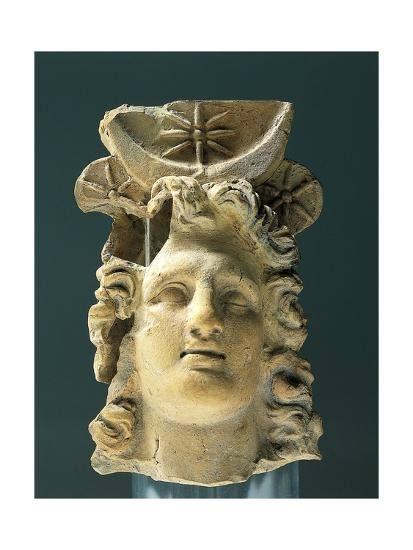
Fragment of Vase. Portrait head of Alexander the Great depicted as the sun god, Alexander was recognized by the oracle of the god Amun Ra in the Siwa Oasis as the gods son.
Hellenistic, 3rd-2nd Century BC. Found at Amisos, Turkey.

Egyptian alabaster statuette of Alexander the Great.
1st century BC - 1st century AD, Hellenistic Period.
This posthumous statue was carved from an Egyptian stone in the Greek style that emphasizes motion by the twist of the head and neck.
-Brooklyn Museum, NYC.
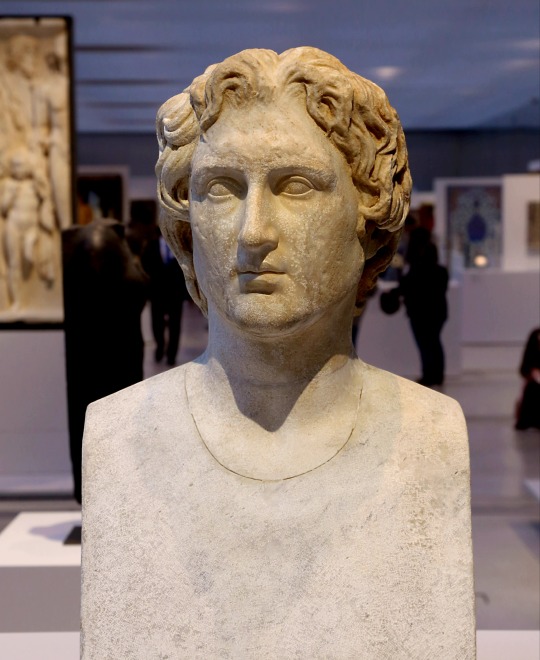
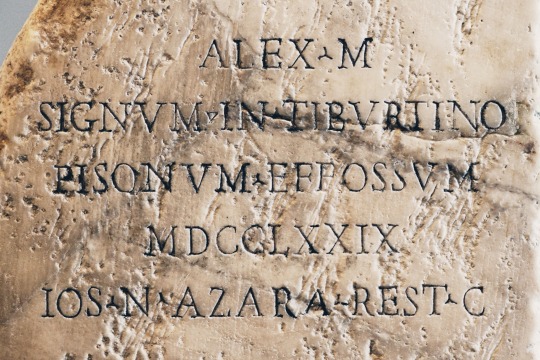
Azara Herm
This work takes the form of a herm: a pillar whose upper part has been sculpted in the shape of a head. It shows a young man, his head slightly lifted.
Thanks to its original antique inscription, this figure can be definitely identified as Alexander the Great, son of Philip II of Macedon. The leonine hair brushed up from the forehead is characteristic of portraits of the Macedonian sovereign.
The work is a copy of the head of a work from 330 BC attributed to Lysippos - doubtless the statue of Alexander with a bronze lance mentioned by Plutarch.
-Louvre Museum, Paris.
-Bonus-
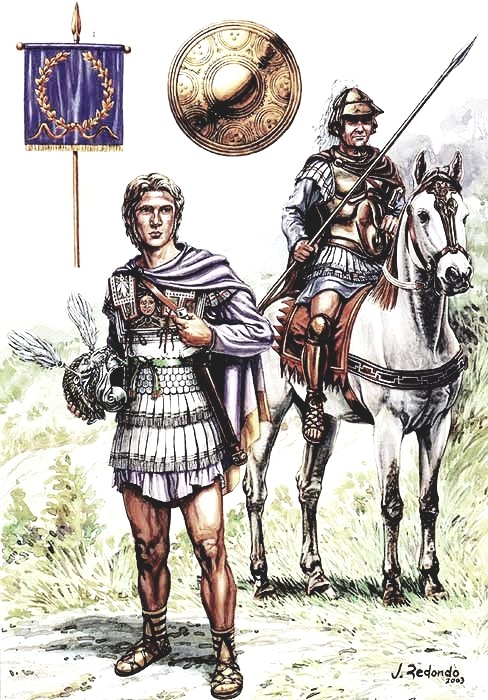
This beautiful work belongs to Mr/Ms J.REDONDO as written on the picture.
The similarity of the figure's face to the portrait of Azara Herm (above mentioned) and the muscular and short structure that conforms to Alexander's general body descriptions make this work very realistic to me.

Marble bust of Alexander the Great in his early years, 175-200 AD.
Found in the area of the ancient agora of Thessaloniki. Perhaps part of a group of cult statues of the family of Alexander in the city. The work was previously described as "head of a woman".
-Thessaloniki Archaeological Museum.
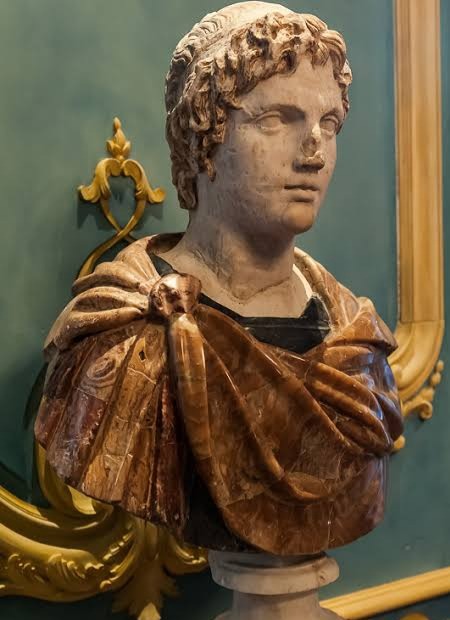
Alexander the Great bust, dressed in paludamentum - stone and colored marble - restored antique head to modern bust. Late Hellenistic or Imperial period.
-Calvet Museum of Avignon, France.
25 notes
·
View notes
Text
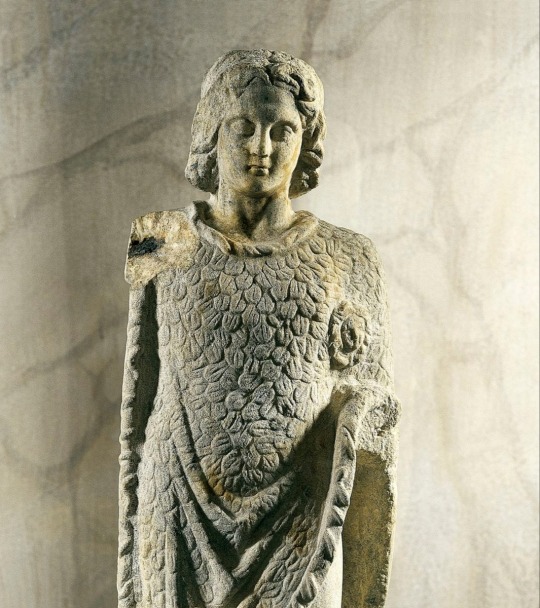
Alexander the Great wearing breastplate, Hellenistic marble statue from El-Manshah, ancient Ptolemais Hermiou, Egypt.
Greek Civilization, 4th-1st Century BC.
-Cambridge, Fitzwilliam Museum.
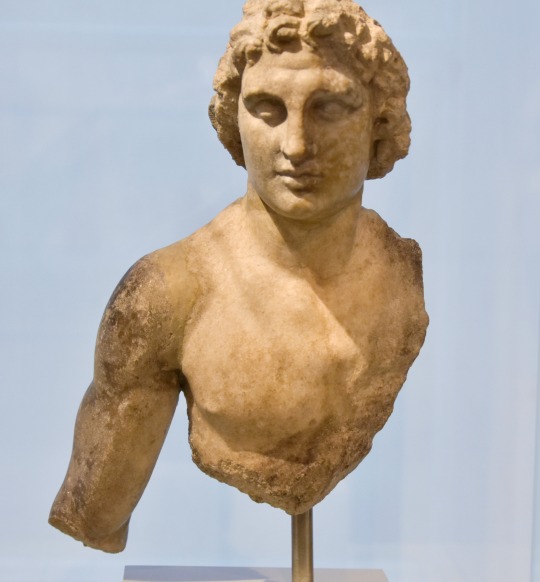
Fragment of a marble statuette of Alexander the Great from Priene.
200-150 BC. Discovered in Priene, Ionia (near Güllübahçe, Turkey) in 1895.
A fragment of a sword hilt with fingers of a left hand, thought to belong to the statuette, is now missing.
-Altes Museum, Berlin.
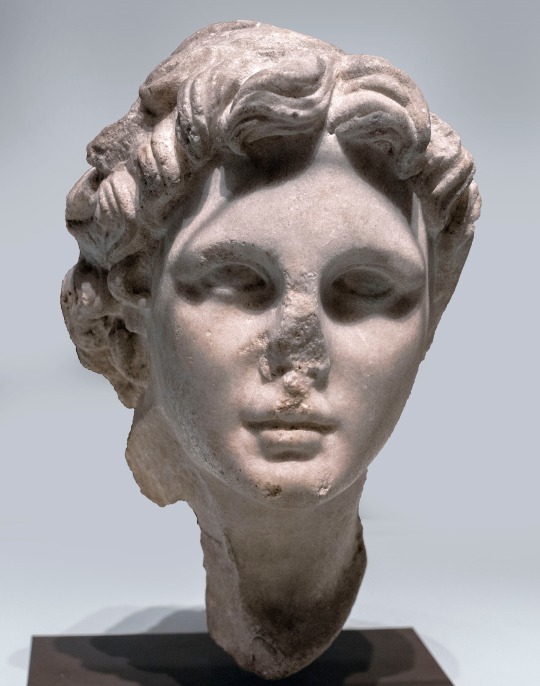
Head of Alexander the Great, known as Alexandre Guimet, marble sculpture found in Cairo, Egypt.
Hellenistic civilisation, 4th-3rd century BC, according to the prototype created by the Athenian sculptor Leochares.
-Paris, Louvre Museum.
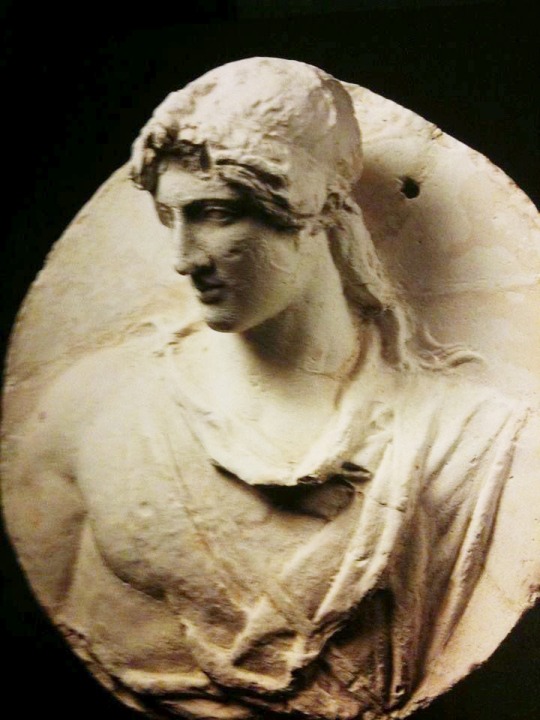
Alexander the Great (found in Afghanistan). Hidden Treasures from the National Museum, Kabul (Australian Review).

This fragment, discovered on the island of Delos, end of the 2nd century BC.
The head may have been encircled by a band or wreath, symbolizing royalty. The heavy oval of the face, the deep-set eyes and the particular arrangement of the hair are all traits pointing to an idealized portrait of Alexander the Great.
-Paris, Louvre Museum.

This bust in the Sale Castellani of the Capitoline Museums' Palazzo dei Conservatori have been placed side of the bronze horse associated with Lysippos.
It's not labelled and so far there is no reference to the statue in the museum's online database.
-Capitoline Museums, Rome.
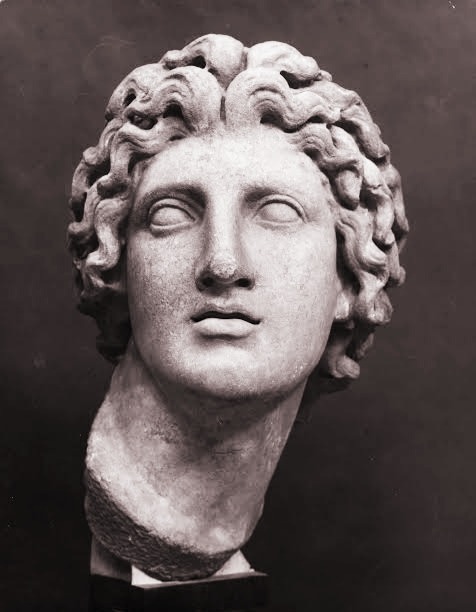
Head of Alexander the Great.
Pentelic marble. 2nd century AD "copy after a Greek original from the late 4th century BC" attributed to Euphranor.
-Barracco Museum, Rome.
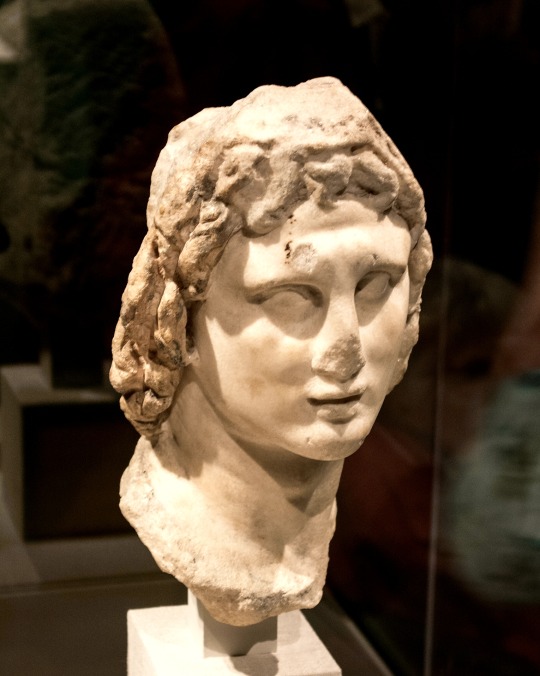
Marble head of Alexander the Great, created in Egypt about 300 to 200 BC. Found at Alexandria.
Ptolemaic Egypt adopted many Hellenistic elements, including artistic styles, and began working in marble. This head of Alexander is from the time of Ptolemy I or Ptolemy II, and was part of a larger statue.
-Cleveland Museum of Art, Ohio.
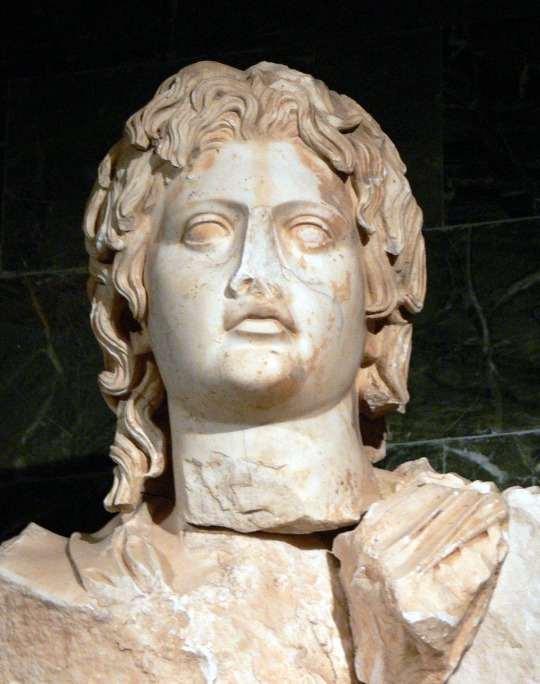
Roman statue of Alexander The Great. From the theatre of Perge. 2nd century AD.
-Antalya Archaeological Museum, Turkey.
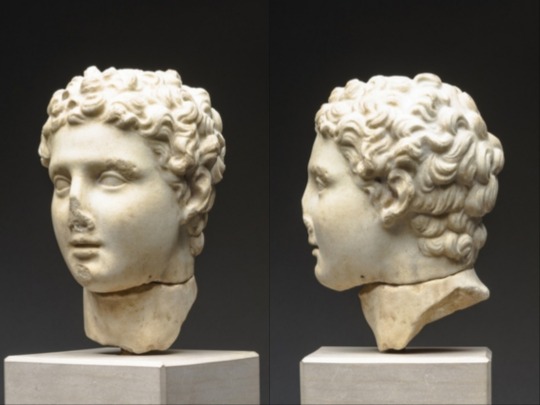
Hellenistic Marble Head of Alexander the Great. 300 BC to 100 BC.
This piece is carved in the Hellenistic style, with intense naturalism and careful attention to detail. The sculpture itself shows Alexander as a boy on the edge of adulthood; at this point in his life (16-18) he was acting regent of Macedon.
The face, while evidently young, is determined, with set lips, a jutting chin and intense, well-modelled eyes. The hair is short yet extravagantly curly.
-Barakat Gallery, London.
47 notes
·
View notes
Text
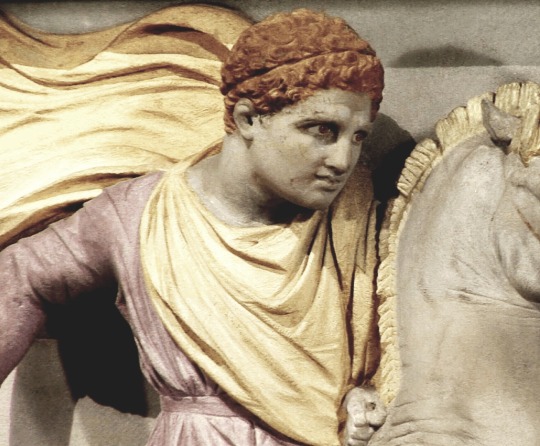
Alexander hunting lions on the marble Alexander Sarcophagus, 4th century BC.
From the Royal Necropolis of Sidon.
His hair, lips and eye contours were in red brown. His head has indentations for attaching a royal diadem.
-Istanbul Archaeological Museum.

A Graeco-Egyptian marble portrait head of Alexander The Great.
Mid-3rd/Mid-2nd Century BC.
The youthful head with short wavy fringe and long loose curls falling down over the nape of his neck, the sockets of his eyes deeply cut originally to have taken inlays, with sensitively modelled 'rings of Venus' on his neck, traces of brown painted gesso on some of the curls, mounted.
The head was believed to have come from Hermopolis (the city of Hermes), modern day Ashmunein.
-Formerly in the Maurice Nahman collection.

Limestone head of Alexander the Great.
Hellenistic period, 250-200 BC.
-Nicosia, Archaeological Museum, Cyprus.

Statue of the Dioskouroi with portrait head of Alexander the Great.
1st century AD. Found at Cyrene (Libya), Baths of Trajan.
-Cyrene Archaeological Museum, Libya.

The heroic courage, the "lion-like" of Alexander, was expressed in his portraits according to the ancient imagery by the strands thrown up over his forehead.
Ca. 270-246 BC from Alexandria.
-Landesmuseum Württemberg, Stuttgart.

Marble statuette of Alexander the Great as the god Pan.
From Pella, Macedonia. Around 300-270 BC.
The figure has two small horns projecting from the top of the head, pointed ears and a goat's tail, in imitation of the rustic half-goat deity Pan, who was popular in Macedonia. It is presumed that the statuette had cloven hooves which are now missing.
-Pella Archeological Museum.

A Hellenistic parian marble portrait head of Alexander The Great. Mid 2nd Century BC.
With luxuriant wavy hair, cupid bow lips and unarticulated eyes, head inclined slightly to left, a hole for fixing a diadem in the top of his head, traces of red on eyes and mouth and remains of gilding, mounted.
-Rheinischen Landesmuseum, Bonn.
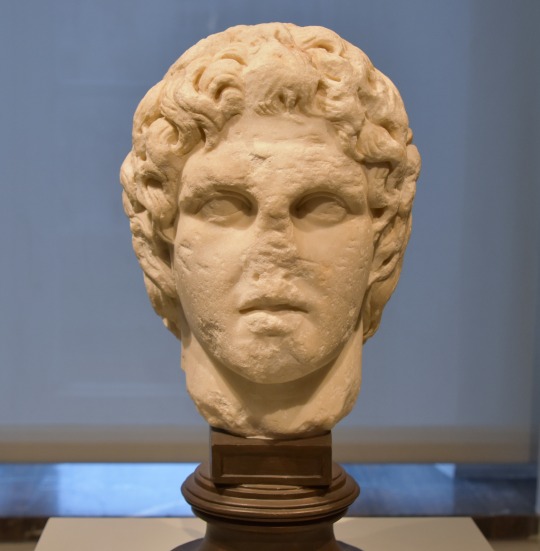
Head of Alexander of the "Erbach type".
The type is named after the best copy, found at Hadrian's Villa, Tivoli, now in Schloss Erbach, Germany. Also known as the "Acropolis-Erbach type" due to the similarity to the head from the Athens Acropolis.
Roman period copy of an original from around 330 BC. Acquired in 1874 in Madytos, Thrace.
-Altes Museum, Berlin.

A Roman replica of a marble head of Alexander the Great. It was found in Kom El Dekka in Alexandria by the Polish expedition. 31 BCE-395 CE.
The head bears the traditional features of the portraits of Alexander the Great which were mooraged by the sculptor Lysippos. The head is inclined to the right, the eyes are gazing meditatively into the distant horizon.
-Antiquities Museum, Bibliotheca Alexandrina.
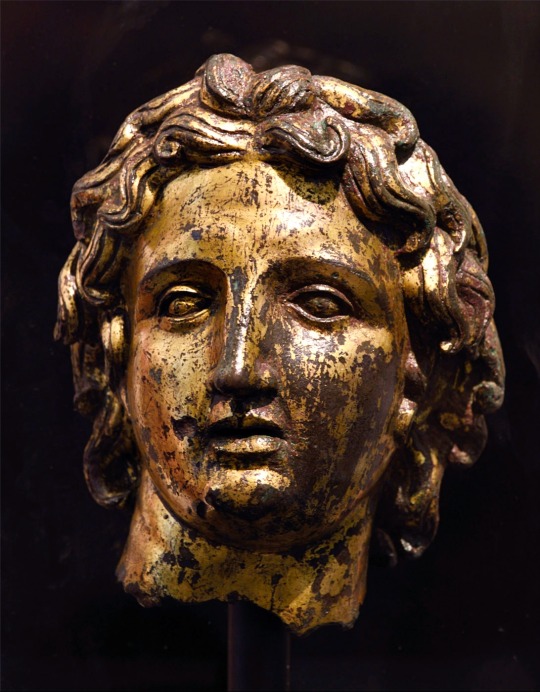
Gilded bronze head of Alexander the Great. 2nd century AD.
-Palazzo Massimo alle Terme, Roman National Museum.
7 notes
·
View notes
Text

1st half of the 2nd century BC. Found in 1900 among rubble above the north hall of the Lower Agora in Pergamon.
The head, along with the rubble, may have fallen from a building uphill from the agora, perhaps the gymnasium.
- Istanbul Archaeological Museum.
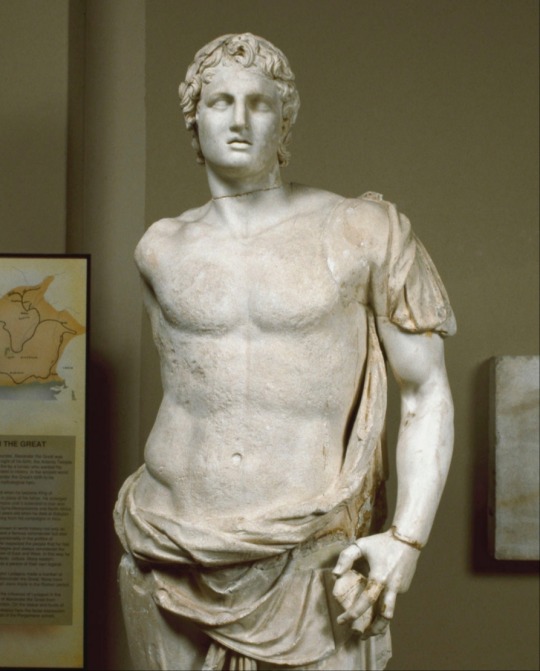
Marble statue from Magnesia ad Sipylum, Lydia. Mid 3rd century BC.
Alexander the Great, wearing a himation (cloak) around his left shoulder and lower body, and with his left hand holding the handle of his sheathed sword.
Found with a marble base inscribed with a dedication to Meter Sipylene, the local mother goddess, and the signature of Means of Pergamon.
-Istanbul Archaeological Museum.

Ptolemaic period, portrait of Alexander the Great, 3rd century BC, from Chatby.
-Geneva Museum of Art and History.

Bust of Alexander the Great in his classic head tilt pose. The original is from Alexandria, Egypt. 2nd - 1st century BC.
Earlier portraits of Alexander tend to appear more heroic and mature, while posthumous portraits, like this example, portray Alexander as a more youthful, god-like character. He has longer hair, a more dynamic twist of the head and an upward gaze; in fact, more like the description of Alexander in literary sources.
-British Museum, London.
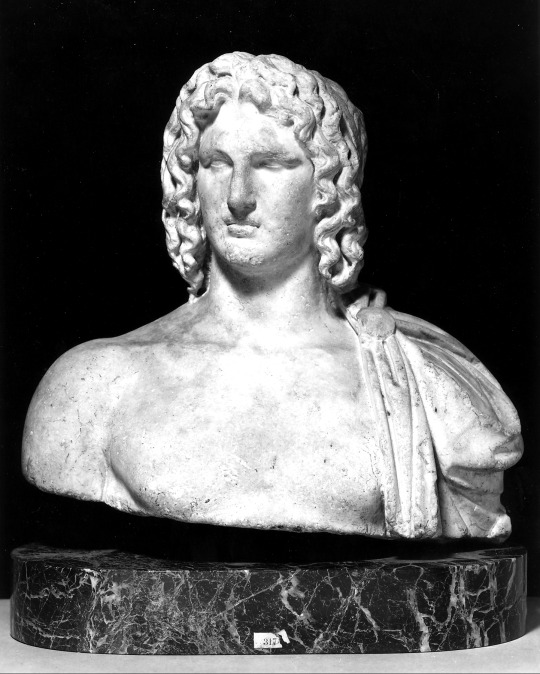
The classically youthful face, the anastole, the long wavy locks, and the hole in the crown for the insertion of a star (a symbol of his deification) identify this work as a portrait of the ruler.
2nd century CE. The Roman date is indicated by the deep grooves in the hair and the artist's rendering of the folds of the mantle as drilled channels.
-Walters Art Museum, Baltimore, Maryland.
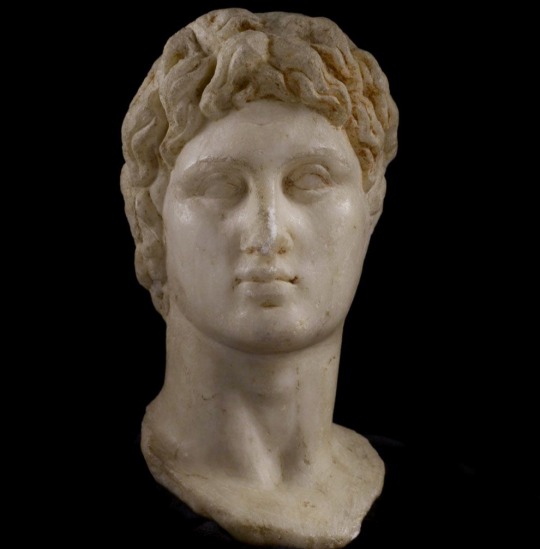
Alexander the Great, depicted in typical Hellenistic style in this alabaster bust from Egypt.
-Eygptian Antiquities Museum, Cairo.

Marble head of Alexander the Great. Chance find from the area of Giannitsa near Pella. 325-300 BC.
-Pella Archeological Museum.

The "Acropolis type", found in 1886 near the Erechtheion of the Athens Acropolis.
Thought to be an original work of the Athenian sculptor Leochares, made 340-330 BC, perhaps after the Battle of Chaironeia (338 BC) when Alexander visited Athens.
-Acropolis Museum, Athens.

Alexander and his copain Hephaestion. Both life-sized heads are said to have been found in Megara as part of a funerary monument for some courtier who admired and probably worshipped Alexander.
The ensemble has been dated to 320 BC, meaning that it was made only three years after Alexander’s death in 323 BC. Striking that these are true Greek heads and no copies made by the Romans in later years.
- Getty Villa, Malibu, LA.
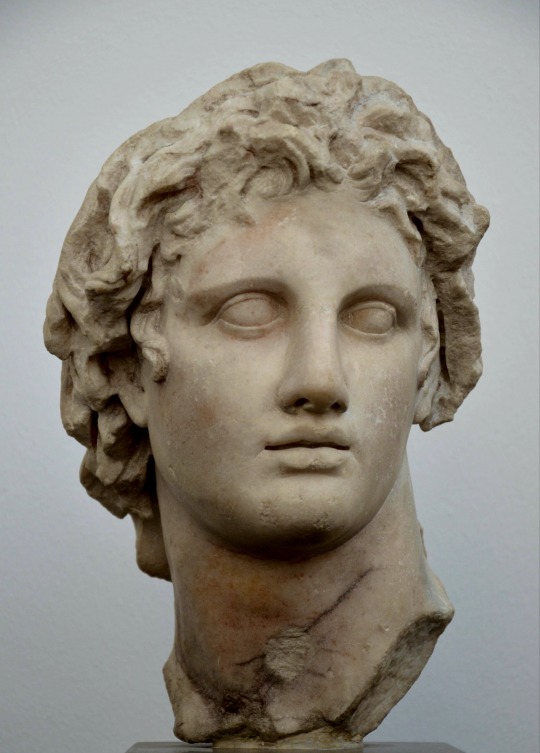
Alexander the Great, copy of a portrait of Lysippos, from Alexandria, Egypt, 3rd cent. BCE.
-Ny Carlsberg Glyptotek, Copenhagen.
15 notes
·
View notes